Abstract
Due to improved mechanical properties, nano-alumina (NA) addition has been considered as an interesting method to promote the performance of cement composites. To investigate the enhancing effect of NA on the fire resistance of cement-based composites, the physical and mechanical properties of NA-modified cement composites (NAMCCs) were experimentally measured after exposure to high temperatures (up to 800 °C). The variation mechanism of the physical properties of NAMCCs with increasing temperature was explored using X-ray diffraction (XRD) and scanning electron microscopy (SEM) methods. Increasing temperature leads to a gradual decrease in density and ultrasonic wave velocity but an overall increase in mass loss. The addition of NA particles effectively improved the mechanical properties of hardened cement pastes after heat treatment at all the temperatures studied. The compressive strength, elastic modulus and flexural strength all gradually decrease with increasing temperature. Combined with the changes in XRD and SEM, three regions are identified for the variation in mechanical performance in the temperature range of 20~400 °C, 400~600 °C and 600~800 °C. Finally, the relation between the physical and mechanical parameters of these regions was evaluated.
1. Introduction
Cement, as the binder of concrete, is a crucial raw material in the construction industry with sharply increasing production and application [1,2,3,4]. Fire resistance is one of the most important parameters that should be considered when using cementitious composites, as it directly influences building repair after fire disaster [5,6]. High temperatures caused by fire disaster not only damage the microstructure of cement-based materials but also lead to phase transformation, which results in changes in mechanical properties [7,8,9,10,11]. Therefore, for buildings with high fire resistance requirements, the thermal effect is not negligible for ensuring their durability and safety. In order to improve resistance against fire/high temperatures, numerous additives have been introduced into cement materials. For instance, Wang et al. [12] evaluated variations in the compressive strength, water absorption, shrinkage and microstructure evolution of cement pastes with 10% metakaolin addition after exposure to elevated temperatures, ranging from room temperature to 800 °C. Kim et al. [13] investigated the effect of high temperatures on the mechanical degradation and thermal decomposition of ethylene–vinyl acetate polymer-modified cement mortar. Flores-Ales et al. [14,15] studied the high temperature behaviors of cement mortars with the incorporations of crushed glass and ferronickel slag aggregate, respectively. Schabowicz et al. [16] provided a nondestructive method to identify the degradation degree of fiber–cement boards under the influence of high temperatures. Nazari et al. [17] investigated the microstructural and mechanical behaviors of ordinary Portland cement and geopolymer concrete affected by thermal shock. Li et al. [18] obtained the effect of the blast furnace slag replacement ratio (0%~55%) on the meso- and microstructure and compressive strength of high-strength concrete and mortar after treatment at 20~800 °C.
In recent years, with the rapid development of nano-manufacturing technology, nano materials have been widely applied to modify the performance of cementitious composites. It has been reported that nanomaterials, such as nano-silica, nano-calcium oxide, nano-titanium dioxide and nano-clay, perform well in strengthening the physical and mechanical properties of cement-based materials [19,20,21,22,23,24,25,26,27,28,29,30,31,32]. Lavergne et al. [19,20,21,22] evaluated the effect of nano-silica particles on the hydration, rheology, impermeability, early compressive strength and microstructure of cement pastes and concrete. Polat et al. [23] investigated variations in the ultrasonic pulse velocity, compressive strength, heat of hydration and linear autogenous shrinkage of cement paste and mortar incorporating nano-calcium oxide with different substitution ratios. Kurihara et al. [24,25,26,27,28,29] added nano-titanium dioxide into cement-based composites to improve their physical and mechanical performance, including drying shrinkage, compressive strength, flexural strength, hydration and photocatalytic properties. Sindu and Sasmal [30] developed a strain-hardening cementitious composite by incorporating fibers of two different length scales, viz. micro- and nano-fibers, to improve the load transfer and crack formation mechanism. Langaroudi et al. [31,32] studied the mechanical performance of cementitious composites with nano-clay addition. Some researchers also found that the fire resistance of cement-based materials can be significantly improved by adding nanomaterials such as multiwalled carbon nanotubes, nano-iron oxide, nano-silica and nano-calcium carbonate [33,34,35,36,37].
Alumina (Al2O3) is an important component of cement particle compounds. Nano-alumina (NA) has natural compatibility with cement and has an extremely high hardness and melting point [38,39]. Its products have high activity in the cement hydration reaction. In addition, nanoparticles have a filling effect by filling the voids between cement particles. The higher filling density results in a lower water requirement for the mixture and reduced capillary porosity, which also improves the compressive strength and flexural strength [38,39,40,41,42,43,44]. However, there is limited literature reporting to evaluate the fire resistance of cement composites with NA addition [45,46,47]. The properties of the high hardness and melting point of NA indicate that it holds great potential to be used in enhancing the fire resistance of cement-based composites. Therefore, the purpose of this study is to systematically explore the influence of thermal effects on the physical and mechanical properties of NA-modified cement composites (NAMCCs), with a view to applying it to buildings with high fire resistance requirements. This work can provide the necessary theoretical basis for fire prevention and the postdisaster assessment and repair of buildings.
In this work, NA with an average diameter of 15.4 nm was selected for the preparation of alumina nanosuspensions using the incorporation of ultrasonication and dispersants. This method has been widely used in dispersing nanomaterials, such as carbon nanotubes, graphene oxide, etc., to obtain a suspension with high dispersibility and long-term stability. Then, physical and mechanical tests were conducted on the NAMCC specimens after heat treatment at different temperatures (20~800 °C) to investigate the effect of exposed temperatures on performance, including density, mass loss, ultrasonic wave velocity, compressive strength, elastic modulus and flexural strength. Finally, the relationships between the physical and mechanical parameters are discussed.
2. Experimental Method
2.1. Preparation of Nano-Alumina Suspensions
Due to the strong van der Waals attraction, pristine nanometer materials are usually formed as large agglomerates, which reduces their reinforcing performance. The efficient dispersion of nanometer material suspensions plays a decisive role in promoting the physical and mechanical performance of modified cement-based composites. In this research, the commercially available NA was purchased from Zhejiang Lixie Instrument Equipment Co., Ltd. (Yiwu, China), with an average surface area of 100 m2/g and an average BET diameter dBET of 15.4 nm, respectively. NA suspensions were prepared using three methods: (1) the conventional stirring method; (2) ultrasonication method; (3) the method of incorporation of ultrasonication and dispersants. For the first method, after deionized water (139.72 g) and NA powders (12 g) were, respectively, put into a glass measuring cup with a volume of 250 mL, a JJ-1B electric blender was used to stir the suspensions with a stirring speed of 2000 rpm for 10 min. The JJ-1B electric blender was manufactured by Xinrui Instruments Co., Ltd. of Jintan City, China, with a maximum stirring speed of 3000 rpm. For the second method, after stirring the suspensions for 10 min, the same as the first method, a horn sonicator (VCX 500W) from Sonics (USA) with a cylindrical tip (13 mm endcap diameter) was utilized for dispersing the suspensions, with an ultrasonication time of 12 min and an ultrasonication powder of 150 W, respectively [43,48]. For the last method, polycarboxylate superplasticizers (SPs, 0.28 g) were added to the suspensions before stirring, with other procedures the same as the second method. In this study, the SP dispersant (CQ-PCE02 polycarboxylate-type superplasticizer), which is produced by Shanghai Chenqi Chemical Technology Co., Ltd. (China), presents as white and powdery. The SP dispersant is a copolymer of isopentenyl polyether with maleic anhydride acrylate and its ester, whose molecule structure shows a comb type. The mass ratio of SPs to NA is constant at 0.2%.
The transmission electron microscope (TEM) tests were conducted on the NA with different preparation methods. A Tecnai G2 F20 S-TWIN transmission electron microscope (Figure 1) manufactured by FEI Company (USA) was employed. The suspensions were dripped on a round copper sheet with a diameter of 3 mm using a dropper. After drying for 24 h, the copper sheet was transferred into the TEM system to test. An accelerating voltage of 120 kV was used during the imaging process. The TEM images of NA particles with different preparation methods are shown in Figure 2. From Figure 2, one can see that the first method was not suitable for dispersing NA particles fully as they presented large agglomerates. The ultrasonication method presents an observable superiority in the dispersion of NA particles compared with the first one. Some of the NA particles interacted with each other to form agglomerates with particle sizes of 200~500 nm. SPs further promoted the dispersion of NA in water. In addition, the prepared NA suspensions are presented in Figure 3, in which the red dotted box indicates the sediment of NA agglomerates. After 8 h, the NA suspensions after ultrasonication with SPs added as the dispersing agent showed little sedimentation, with most NA particles remaining in suspension. This method presents a great dispersing effect on the NA in the water, which was selected to prepare the NA suspensions for the following study.
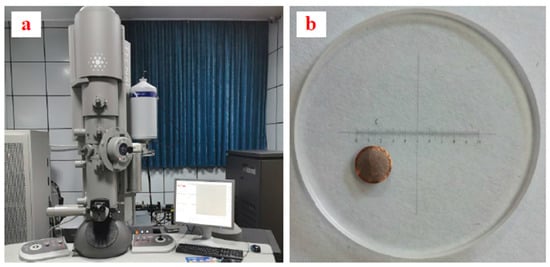
Figure 1.
The projection electron microscope observation equipment used: (a) Tecnai G2 F20 S-TWIN transmission electron microscope and (b) round copper sheet.

Figure 2.
TEM images of NA particles after (a) conventional stirring, (b) conventional ultrasonication and (c) ultrasonication with SPs added as the dispersing agent, respectively.
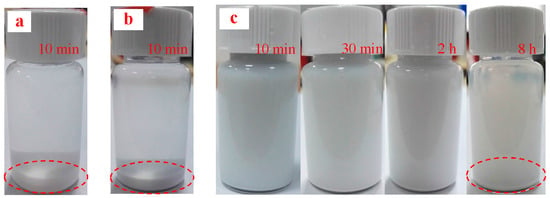
Figure 3.
Nano-Al2O3 suspensions after (a) conventional stirring, (b) conventional ultrasonication and (c) ultrasonication with SPs added as the dispersing agent, respectively. (Red dotted box: sediment.)
2.2. Preparation of NAMCC Specimens
Composite Portland cement (P.C, Type 32.5R) was selected in this study, supplied by Zhonglian Cement Co., Ltd. in Xuzhou City, China. The maximum particle size of this cement was about 80 μm.
NA powders, SPs, water and cement were first weighed. Then, NA powders and SPs were added into the water to produce the NA suspensions using the method of incorporation of ultrasonication and SP dispersant. After that, the prepared NA suspensions were mixed in cement powders using the electric blender with the mixing speeds of first 500 rpm and then 2000 rpm, respectively, for each 10 min. The detailed mass mixing ratios of the prepared fresh pastes are listed in Table 1. Two mass ratios of NA particles to cement (NA/C), 3.0% and 5.0%, were considered in this study. The fresh pastes without NA particles were prepared as a reference (simply Ref later). The mass ratio of SPs to NA particles (SPs/NA) was constant at 0.2%. The mass ratio of water and SPs to cement ((W + SPs)/C) was constant at 0.35.

Table 1.
Mass mixing ratios of the prepared fresh pastes (%). W and C indicate water and cement, respectively. (NA: nano-Al2O3, W: water, SPs: superplasticizers, C: cement).
After pouring the fresh pastes into the molds, the whole system was vibrated to release any residual air bubbles. Two kinds of cuboid- and cylindroid-shaped molds were used, with the corresponding fresh paste volumes of 20.23 and 13.19 cm3, respectively. The shaped specimens were cured for 24 h at a constant temperature of 20 °C and a relative humidity of 95% before demolding and then continually cured for another 27 days in the same environment. After curing, the hardened NAMCC specimens were dried in a laboratory environment with a constant temperature of 20 °C and a relative humidity of 40%, respectively. Before testing, the end surfaces of the specimens were polished flat.
After curing for 28 days, an X-ray diffraction (XRD) test was carried out on NAMCC specimens. The XRD data were used by the Rigaku U1tima IV X-ray diffractometer (Tokyo, Japan), whose goniometer step was 1/10,000 degree. A scraper was used to scrape powder from multiple specimens of the same group. The particles were ground using a ball mill, and the XRD test was performed after grinding to less than 360 meshes. The XRD results of hardened NAMCCs after curing for 28 days are shown in Figure 4. They indicate that ettringite (AFt), calcium hydroxide (CH), calcium silicate hydrate (C-S-H) gel and calcium di-aluminate (CA2) are the main components of the matrices.
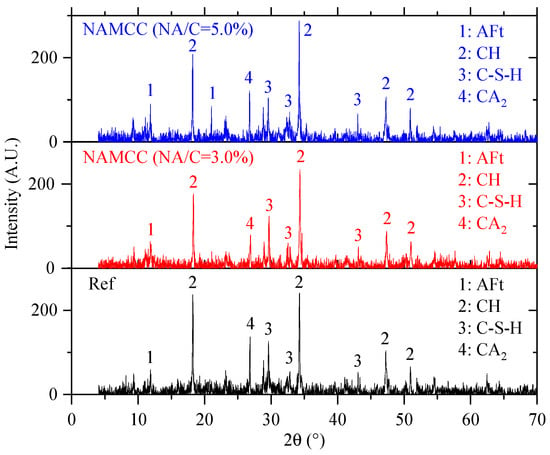
Figure 4.
XRD results of hardened NAMCCs after curing for 28 days.
2.3. Heat Treatment and Testing Contents
The hardened specimens were subjected to heat treatment at different temperatures using a MXQ1700 box-type furnace produced by Shanghai Micro-X Furnace Co., Ltd. (Shanghai, China). In the heat treatment, specimens were first heated to the designated temperatures (200, 400, 600 and 800 °C, respectively) with a constant rate of 5 °C per minute and then cooled to room temperature after being kept at the designed temperatures for 2 h. The specimens after heat treatment are shown in Figure 5.

Figure 5.
NAMCC specimens subjected to high temperatures and the schematic diagrams for uniaxial compressive and three-point bending tests, respectively.
A total of 150 specimens of two shapes were prepared for this work. Uniaxial compressive tests were carried out on cylindrical specimens with a diameter of 20 mm and a height of 40 mm to obtain their compressive strength and elastic modulus. Another 60 cuboid specimens were taken for the three-point bending test, and the width, height and thickness of the specimens were 68, 17 and 17 mm, respectively. A DNS100 rock mechanics testing system, with a maximum loading capacity of 100 kN, was used to conduct the uniaxial compressive and three-point bending tests. For the uniaxial compressive tests, constant displacement mode with the rate of 1.3 × 10−3 mm per second was used in the loading process. For the three-point bending tests, three round steel bars with a diameter of 4 mm were applied. Two bars were placed under the specimens with distance of 50 mm (L). Another one was put in the middle of the top of specimen to apply the line load. Flexural strength Rf can be calculated using the following equation:
where Ff is the peak load, and b is the side length of the square section of cuboid specimens (17 mm).
Physical properties, including mass loss, density and ultrasonic wave velocity of the heat-treated hardened specimens at different temperatures, were also measured prior to the uniaxial compression and three-point bending tests, as shown in Figure 6, where NA/C denotes the mass ratio of NA particles to cement. The ultrasonic wave velocity was measured using an NM-4A ultrasonic testing system produced by Beijing Concrete Engineering Testing Technology Co., Ltd., Beijing, China and the testing method is shown in Figure 7. During the test, Vaseline lubricant was applied to both ends of the specimen to improve the coupling effect between specimen and testing probe. It is worth noting that the specimens without heat treatment were also tested, and the room temperature was 20 °C.
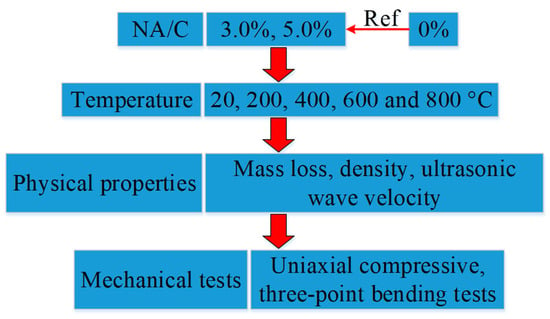
Figure 6.
Main testing contents.
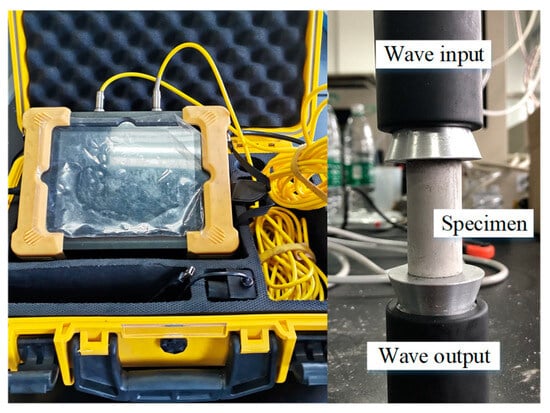
Figure 7.
NM-4A ultrasonic testing system and the testing method.
3. Results Analysis and Discussion
3.1. Physical Properties
The variations in density, mass loss level and ultrasonic wave velocity of NAMCCs at different temperatures are shown in Figure 8, in which the mass loss level indicates the ratio of losing mass after increasing temperature to the pristine mass. With an increase in temperature, the density and ultrasonic wave velocity gradually decrease in general, while the mass loss level presents an increasing trend. In the case of NAMCCs with a NA/C of 3.0%, for example, the density decreases from 1.90 to 1.62 g/cm3 with an increase in temperature from 20 °C to 800 °C, with a decrease of 14.74%. The ultrasonic wave velocity decreases by 28.34%, from 2.47 to 1.77 km/s. However, the mass loss level increases to 20.72%.
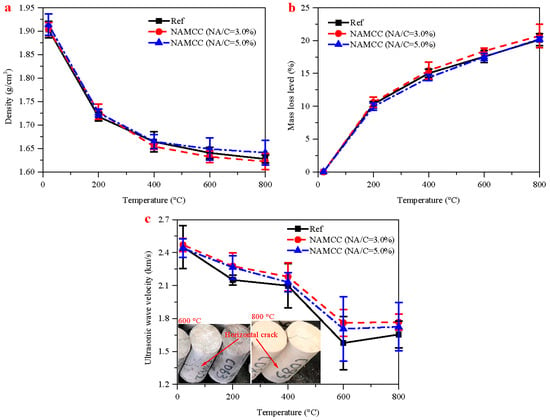
Figure 8.
Effects of the temperature on (a) density, (b) mass loss level and (c) ultrasonic wave velocity of NAMCCs. Error bar indicates one standard deviation, and four specimens were tested for each case.
In order to study the variation mechanism of physical properties with increasing temperature, XRD tests were also conducted on the NAMCCs after heat treatment, as shown in Figure 9. During the heating treatment, a series of physical and chemical reactions appear in the NAMCCs, as follows:
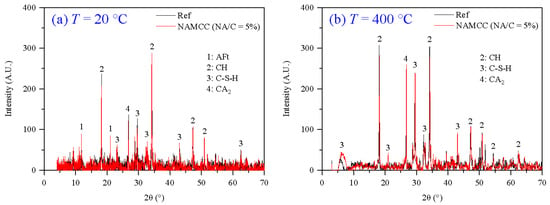
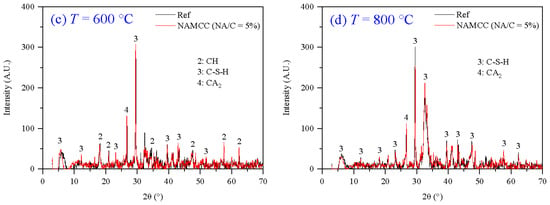
Figure 9.
XRD results of NAMCCs after heat treatment at different temperatures.
- (1)
- In the temperature range of room temperature to 400 °C, free water escapes from the NAMCCs [37,45]. Ettringite (AFt) undergoes thermal decomposition, and C-S-H dehydration appears, as shown in Figure 9a,b. These reactions in NAMCCs result in serious mass loss and density reduction [47]. In this stage, the density decreases by 12.58% (Ref), 13.14% (NA/C = 3.0%) and 13.03% (NA/C = 5.0%), respectively. The mass loss level sharply increases to 15.02% (Ref), 15.42% (NA/C = 3.0%) and 14.35% (NA/C = 5.0%), respectively. The thermal decomposition and dehydration of minerals also lead to slight structure damage and the attenuation of ultrasonic wave velocity, with extents of 14.42% (Ref), 11.77% (NA/C = 3.0%) and 12.72% (NA/C = 5.0%), respectively;
- (2)
- In the temperature range of 400 to 600 °C, calcium hydroxide (CH) drastically thermal decomposes into calcium oxide and water [37], as shown in Figure 9b,c. The thermal decomposition of CH leads to a continuous decrease in physical parameters. In this stage, the density of NAMCCs decreases by 1.42% (Ref), 1.32% (NA/C = 3.0%) and 0.95% (NA/C = 5.0%), respectively. The mass loss level increases to 17.55% (Ref), 18.39% (NA/C = 3.0%) and 17.50% (NA/C = 5.0%), respectively. Meanwhile, macroscopic cracks were observed on the specimens, as shown in Figure 8c. The thermal decomposition and macroscopic cracking result in a drastic reduction in ultrasonic wave velocity, with the extents of 24.84% (Ref), 19.24% (NA/C = 3.0%) and 19.92% (NA/C = 5.0%), respectively;
- (3)
- In the temperature range of 600 to 800 °C, the residual CHs are almost decomposed completely, as shown in Figure 9c,d, resulting in a decrease in density of 0.79% (Ref), 0.62% (NA/C = 3.0%) and 0.48% (NA/C = 5.0%), respectively. The mass loss level continues to increase to 20.12% (Ref), 20.72% (NA/C = 3.0%) and 20.22% (NA/C = 5.0%), respectively. In addition, there is an observable increase in the scale and number of macroscopic cracks, as shown in Figure 8c. However, due to the weak change in the solid particle network in NAMCCs, the variation in ultrasonic wave velocity is not significant in this stage.
Due to the water loss and thermal decomposition of NAMCCs, the specimens, in general, present a shrinking feature with increasing temperature [49]. In order to quantitatively describe the shrinking feature, the height and diameter change levels of cylindrical NAMCC specimens were defined, respectively.
where Δh and Δd mean the height and diameter change levels, respectively (positive indicating shrinking and negative indicating expanding). hb and db represent the height and diameter before heat treatment, respectively. ha and da indicate the height and diameter after heat treatment, respectively.
The variations in height and diameter change levels at different temperatures are shown in Figure 10. Before 400 °C, the height and diameter of cylindrical NAMCC specimens did not change much, whereas when the temperature exceeds 400 °C, the magnitude of the change in height and diameter increases dramatically, and the specimens show an obvious shrinking feature. Taking the cylindrical NAMCC with a NA/C of 3.0%, for instance, when temperature rises from 400 to 800 °C, the height change level increases from 0.26% to 2.43%, and the diameter change level also increases from 0.92% to 2.75%.
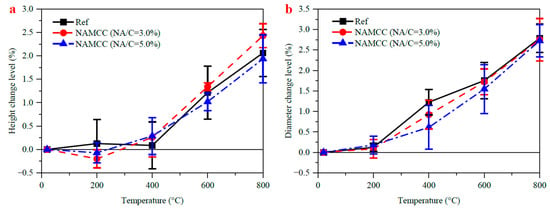
Figure 10.
Effects of the temperature on (a) height and (b) diameter change levels of cylindrical NAMCC specimens. Error bar indicates one standard deviation, and four specimens were tested for each case.
3.2. Mechanical Performance
The variations in compressive strength, elastic modulus and flexural strength of NAMCC specimens at different temperatures collected from uniaxial compressive and three-point bending tests are shown in Figure 11. The compressive strength, elastic modulus and flexural strength keep decreasing with increasing temperature. Taking the specimens with an NA/C of 3.0%, for instance, from room temperature to 800 °C, the compressive strength decreases from 37.24 to 18.82 MPa, with an extent of 49.46%, and the elastic modulus decreases by 60.04%, from 4.78 to 1.91 GPa. Similarly, the flexural strength reduces by 77.06%, from 6.19 to 1.42 MPa.
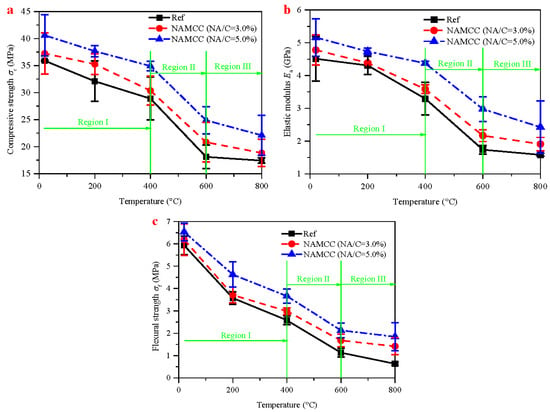
Figure 11.
Effects of temperature on (a) compressive strength, (b) elastic modulus and (c) flexural strength of NAMCC specimens. Error bar indicates one standard deviation, and four specimens were tested for each case.
Combined with the changes in XRD and SEM, the changes in the mechanical parameters in the temperature range of 20~800 °C are divided into three stages:
- (1)
- At 20~400 °C, the compressive strength decreases by 19.50% (Ref), 18.47% (NA/C = 3.0%) and 14.01% (NA/C = 5.0%), respectively. The reduction extent of the elastic modulus is 26.97% (Ref), 24.95% (NA/C = 3.0%) and 15.29% (NA/C = 5.0%), respectively. And the flexural strength also reduces by 56.50% (Ref), 51.79% (NA/C = 3.0%) and 44.01% (NA/C = 5.0%), respectively.
- (2)
- At 400~600 °C, the mechanical parameters continue to decrease under various working conditions. When the NA/C is 3.0%, the compressive strength and elastic modulus decrease by 31.42% and 39.53%, respectively. When the NA/C is 5.0%, the compressive strength and elastic modulus decrease by 28.74% and 31.94%, respectively. This is mainly due to the thermal decomposition of the main component CH (Figure 9b,c). The reduction in a large number of CH components leads to a sharp decline in the mechanical properties;
- (3)
- At 600~800 °C, the downward trend of mechanical parameters slows down. The mechanical parameters continue to decrease gently. Taking the specimens with the NA/C of 3.0%, as an example, from 600 to 800 °C, the compressive strength, elastic modulus and flexural strength reduce by 9.65%, 11.95% and 15.48%, respectively. This is because the residual CHs undergo thermal decomposition, as shown in Figure 9c,d.
In addition to the macroscopic cracks observed after 400 °C (Figure 8c), the development of microscopic cracks (Figure 12) was also observed. These cracks indicate that the temperature effect will significantly erode the mechanical properties. It can also be seen from Figure 12 that as the heat treatment temperature increases, the size and number of macroscopic cracks increase significantly. High temperatures will also lead to a decrease in the adhesive performance between the internal minerals, accompanied by the shedding of mineral particles. Moreover, the addition of NA also has a significant effect on the propagation and condensation of microcracks.

Figure 12.
SEM images of NAMCCs after heat treatment at different temperatures. The red dotted line indicates microscopic cracks.
From Figure 11 and Figure 12, it is clear that NA effectively improves the mechanical performance affected by high temperatures, and in this study, the larger the NA/C, the better the mechanical performance is. For instance, at 400 °C, when the NA/C is 3.0%, the compressive strength, elastic modulus and flexural strength increase by 5.09%, 8.84% and 15.50%, respectively, compared with those of Ref. For the NA/C with 5.0% NA, further enhancement of the compressive strength, elastic modulus and flexural strength reaches 20.86%, 32.77% and 41.82%, respectively. In order to further evaluate the enhancement effect of NA particles on the mechanical performance in this study, the reinforcing coefficient RC is defined as follows:
where MPn and MP0 are, respectively, indicated as the mechanical parameters of hardened pastes with and without NA particle addition.
Variations in the reinforcing coefficients of the compressive strength, elastic modulus and flexural strength of NAMCC specimens at different temperatures are shown in Figure 13. In general, the reinforcing coefficients of the mechanical parameters present an increasing trend with increasing temperature. The reinforcing effect of flexural strength is preferable, especially above 400 °C.
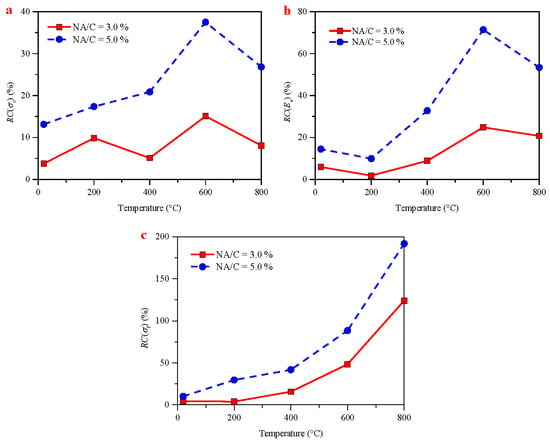
Figure 13.
Variations in the reinforcing coefficients of (a) compressive strength, (b) elastic modulus and (c) flexural strength of NAMCC specimens at different temperatures.
3.3. Discussion
As a general rule, there is a certain connection between the physical and mechanical parameters of rocks or cement composites. Du et al. [48] applied linear and exponential functions to describe the effect of porosity on the compressive strength and elastic modulus of hardened cement composites at an age of 28 days, respectively. Zhang et al. [50,51] built the relationships between the electrical resistivity and uniaxial compressive strength of two kinds of Linyi (China) sandstones after thermal damage. Sun et al. [52] obtained the linear connection of tensile strength with the P-wave velocity and thermal conductivity of sandstone under the combined effects of salt, cyclic wetting and drying cycles.
In this study, with increased density and ultrasonic wave velocity, the compressive strength, elastic modulus and flexural strength all generally increase in the temperature range between room temperature and 800 °C. However, the mechanical parameters appear to have a negative correlation with the mass loss level. Hence, the relations between the mechanical parameters (including compressive strength, elastic modulus and flexural strength) and physical parameters (including density, mass loss level and ultrasonic wave velocity) were, respectively, discussed. By comparing the fitting results, exponential, quadratic and linear functions were determined for the density, mass loss level and ultrasonic wave velocity, respectively, as follows:
where ρ, k and v mean the density, mass loss level and ultrasonic wave velocity, respectively. MP indicates the mechanical parameters (i.e., compressive strength, elastic modulus and flexural strength). And a, b, c, , , and are fitting parameters obtained from the least square fitting.
The fitting results between the physical and mechanical parameters are listed in Table 2, in which the relation between the density and flexural strength for the NAMCC (NA/C = 3%) is weak, and no correlation was obtained. The fitting coefficient R2 ranged from 0.852 to 0.978, illustrating that increasing exponential function, reducing quadratic function and increasing linear function can be applied to reasonably describe the relations of density, mass loss level and ultrasonic wave velocity, respectively, with the mechanical parameters in general.

Table 2.
Fitting results between physical and mechanical parameters. The front number indicates the fitting coefficient R2, and the latter symbols A, B and C indicate the fitting equations, i.e., Equations (5), (6) and (7), respectively.
4. Conclusions
In order to investigate the enhancing effect of NA on the fire resistance of cement-based composites, NAMCC specimens were prepared and tested for their physical and mechanical parameters at different temperatures (ranging from 20 to 800 °C). Density, mass loss, ultrasonic wave velocity, compressive strength, elastic modulus and flexural strength were measured and analyzed. The main conclusions were obtained, as follows:
- (1)
- Compared with conventional stirring and ultrasonication methods, the ultrasonication method with the addition of SPs is more effective in dispersing NA in water, and the suspensions obtained have high dispersibility and long-term stability;
- (2)
- Increasing temperature causes a gradual reduction in density and ultrasonic wave velocity but an increase in mass loss. Due to water loss and the thermal decomposition of minerals in NAMCCs, specimens present a shrinking feature with increasing temperature in general. The shrinkage trend becomes more obvious after 400 °C, and the change level of height and diameter increased by 2.43% and 2.75%, respectively, when reaching 800 °C;
- (3)
- The compressive strength, elastic modulus and flexural strength of the NAMCCs gradually decrease with increasing temperature. Three variation regions in mechanical performance were identified in the tested temperature range: 20~400 °C, 400~600 °C and 600~800 °C, respectively. The addition of NA particles effectively improved the mechanical parameters of the hardened cement pastes;
- (4)
- Mathematical functions were used to effectively describe the relationship between the physical and mechanical parameters of NAMCCs after heat treatment. Specifically, increasing exponential function, decreasing quadratic function and increasing linear function were used to describe the relationship between density, mass loss level and ultrasonic wave velocity and mechanical parameters, respectively.
Emerging materials such as nanomaterials provide important support for the research and development of refractory materials. This work mainly focuses on the physical and mechanical properties of NAMCCs after heat treatment at different temperatures of 20~800 °C in order to evaluate the deterioration of the mechanical properties of modified cement slurry after fire to apply to buildings with high requirements for fire resistance. However, under fire conditions (real-time high temperatures), the performance of NAMCCs is also crucial for understanding the fire resistance and strengthening mechanism, which will be our future research topic.
Author Contributions
Conceptualization, M.W. and Y.J.; Formal analysis, M.W.; Funding acquisition, H.S.; Investigation, M.W., Y.J. and S.L.; Methodology, M.W., Y.J. and S.L.; Project administration, S.L. and Z.C.; Resources, M.W. and H.S.; Supervision, S.L. and Z.C.; Writing—original draft, M.W.; Writing—review and editing, Y.J. All authors have read and agreed to the published version of the manuscript.
Funding
This study was financed by the Open Research Fund of State Key Laboratory of Coking Coal Resources Green Exploitation, China Pingmei Shenma Group, Grant No. 41040220201308.
Data Availability Statement
The data used to support the findings of this study are available from the corresponding author upon request.
Conflicts of Interest
The authors declare that they have no competing interests or personal relationships that could have appeared to influence the work reported in this paper.
References
- Shen, L.; Gao, T.M.; Zhao, J.N.; Wang, L.M.; Wang, L.; Liu, L.T.; Chen, F.N.; Xue, J.J. Factory-level measurements on CO2 emission factors of cement production in China. Renew. Sustain. Energy Rev. 2014, 34, 337–349. [Google Scholar] [CrossRef]
- Schneider, M. Process technology for efficient and sustainable cement production. Cem. Concr. Res. 2015, 78, 14–23. [Google Scholar] [CrossRef]
- Shen, W.G.; Liu, Y.; Yan, B.L.; Wang, J.; He, P.T.; Zhou, C.C.; Huo, X.J.; Zhang, W.Z.; Xu, G.L.; Ding, Q.J. Cement industry of China: Driving force, environment impact and sustainable development. Renew. Sustain. Energy Rev. 2017, 75, 618–628. [Google Scholar] [CrossRef]
- Rakhimova, N.R.; Rakhimov, R.Z. Toward clean cement technologies: A review on alkali-activated fly-ash cements incorporated with supplementary materials. J. Non-Cryst. Solids 2019, 509, 31–41. [Google Scholar] [CrossRef]
- Ahmad, H.; Hameed, R.; Riaz, M.R.; Gillani, A.A. Strengthening of concrete damaged by mechanical loading and elevated temperature. Adv. Concr. Constr. 2018, 6, 645–658. [Google Scholar]
- Akca, A.H.; Ozyurt, N. Deterioration and recovery of FRC after high temperature exposure. Cem. Concr. Compos. 2018, 93, 260–273. [Google Scholar] [CrossRef]
- Karim, M.R.; Chowdhury, F.I.; Zabed, H.; Saidur, M.R. Effect of elevated temperatures on compressive strength and microstructure of cement paste containing palm oil clinker powder. Constr. Build. Mater. 2018, 183, 376–383. [Google Scholar] [CrossRef]
- Gokce, H.S. High temperature resistance of boron active belite cement mortars containing fly ash. J. Clean. Prod. 2019, 211, 992–1000. [Google Scholar] [CrossRef]
- Bjorge, R.; Gawel, K.; Panduro, E.A.C.; Torsaeter, M. Carbonation of silica cement at high-temperature well conditions. Int. J. Greenh. Gas Control 2019, 82, 261–268. [Google Scholar] [CrossRef]
- Scheinherrova, L.; Vejmelkova, E.; Keppert, M.; Bezdicka, P.; Dolezelova, M.; Krejsova, J.; Grzeszczyk, S.; Matuszek-Chmurowska, A.; Cerny, R. Effect of Cu-Zn coated steel fibers on high temperature resistance of reactive powder concrete. Cem. Concr. Res. 2019, 117, 45–57. [Google Scholar] [CrossRef]
- Borinaga-Trevino, R.; Orbe, A.; Norambuena-Contreras, J.; Canales, J. Effect of microwave heating damage on the electrical, thermal and mechanical properties of fibre-reinforced cement mortars. Constr. Build. Mater. 2018, 186, 31–41. [Google Scholar] [CrossRef]
- Wang, W.Q.; Liu, X.H.; Guo, L.; Duan, P. Evaluation of properties and microstructure of cement paste blended with metakaolin subjected to high temperatures. Materials 2019, 12, 941. [Google Scholar] [CrossRef] [PubMed]
- Kim, H.J.; Park, J.Y.; Suh, H.W.; Cho, B.Y.; Park, W.J.; Bae, S.C. Mechanical degradation and thermal decomposition of ethylene-vinyl acetate (EVA) polymer-modified cement mortar (PCM) exposed to high-temperature. Sustainability 2019, 11, 500. [Google Scholar] [CrossRef]
- Flores-Ales, V.; Jimenez-Bayarri, V.; Perez-Fargallo, A. The influence of the incorporation of crushed glass on the properties and high temperature behaviour of cement mortars. Bol. Soc. Esp. Ceram. Vidrio 2018, 57, 257–265. [Google Scholar]
- Saha, A.K.; Sarker, P.K.; Golovanevskiy, V. Thermal properties and residual strength after high temperature exposure of cement mortar using ferronickel slag aggregate. Constr. Build. Mater. 2019, 199, 601–612. [Google Scholar] [CrossRef]
- Schabowicz, K.; Gorzelanczyk, T.; Szymkow, M. Identification of the degree of fibre-cement boards degradation under the influence of high temperature. Autom. Constr. 2019, 101, 190–198. [Google Scholar] [CrossRef]
- Nazari, A.; Bagheri, A.; Sanjayan, J.G.; Dao, M.; Mallawa, C.; Zannis, P.; Zumbo, S. Thermal shock reactions of Ordinary Portland cement and geopolymer concrete: Microstructural and mechanical investigation. Constr. Build. Mater. 2019, 196, 492–498. [Google Scholar] [CrossRef]
- Li, Z.W.; Li, L.; Wang, J.K.; Wu, X.H. Effect of elevated temperature on meso- and micro-structure and compressive strength of high-strength concrete and mortar containing blast-furnace slag. J. Adv. Concr. Technol. 2018, 16, 498–511. [Google Scholar] [CrossRef]
- Lavergne, F.; Belhadi, R.; Carriat, J.; Fraj, A.B. Effect of nano-silica particles on the hydration, the rheology and the strength development of a blended cement paste. Cem. Concr. Compos. 2019, 95, 42–55. [Google Scholar] [CrossRef]
- Liu, M.; Tan, H.B.; He, X.Y. Effects of nano-SiO2 on early strength and microstructure of steam-cured high volume fly ash cement system. Constr. Build. Mater. 2019, 194, 350–359. [Google Scholar] [CrossRef]
- Sun, J.F.; Shen, X.D.; Tan, G.; Tanner, J.E. Modification effects of nano-SiO2 on early compressive strength and hydration characteristics of high-volume fly ash concrete. J. Mater. Civ. Eng. 2019, 31, 04019057. [Google Scholar] [CrossRef]
- Zhang, B.L.; Tan, H.B.; Shen, W.G.; Xu, G.L.; Ma, B.G.; Ji, X.L. Nano-silica and silica fume modified cement mortar used as surface protection material to enhance the impermeability. Cem. Concr. Compos. 2018, 92, 7–17. [Google Scholar] [CrossRef]
- Polat, R.; Demirboga, R.; Karagol, F. Mechanical and physical behavior of cement paste and mortar incorporating nano-CaO. Struct. Concr. 2019, 20, 361–370. [Google Scholar] [CrossRef]
- Kurihara, R.; Maruyama, I. Impact of TiO2 nanoparticles on drying shrinkage of hardened cement paste. J. Adv. Concr. Technol. 2018, 16, 272–281. [Google Scholar] [CrossRef]
- Wang, L.; Zhang, H.L.; Gao, Y. Effect of TiO2 nanoparticles on physical and mechanical properties of cement at low temperatures. Adv. Mater. Sci. Eng. 2018, 2018, 8934689. [Google Scholar] [CrossRef]
- Yuenyongsuwan, J.; Sinthupinyo, S.; O’Rear, E.A.; Pongprayoon, T. Hydration accelerator and photocatalyst of nanotitanium dioxide synthesized via surfactant-assisted method in cement mortar. Cem. Concr. Compos. 2019, 96, 182–193. [Google Scholar] [CrossRef]
- Liu, M.; Xiao, H.G.; Liu, R.; Liu, J.L. Dispersion characteristics of various contents of nano-TiO2 and its effect on the properties of cement-based composite. Struct. Concr. 2018, 19, 1301–1308. [Google Scholar] [CrossRef]
- Zhao, P.Q.; Wang, H.; Wang, S.D.; Du, P.; Lu, L.C.; Cheng, X. Assessment of nano-TiO2 enhanced performance for photocatalytic polymer-sulphoaluminate cement composite coating. J. Inorg. Organomet. Polym. Mater. 2018, 28, 2439–2446. [Google Scholar] [CrossRef]
- Li, Z.; Wang, J.L.; Li, Y.; Yu, X.; Han, B.G. Investigating size effect of anatase phase nano TiO2 on the property of cement-based composites. Mater. Res. Express 2018, 5, 085034. [Google Scholar] [CrossRef]
- Sindu, B.S.; Sasmal, S. On the development and studies of nano- and micro-fiber hybridized strain hardened cementitious composite. Arch. Civ. Mech. Eng. 2019, 19, 348–359. [Google Scholar] [CrossRef]
- Langaroudi, M.A.M.; Mohammadi, Y. Effect of nano-clay on workability, mechanical, and durability properties of self-consolidating concrete containing mineral admixtures. Constr. Build. Mater. 2018, 191, 619–634. [Google Scholar] [CrossRef]
- Girgin, Z.C. Effect of slag, nano clay and metakaolin on mechanical performance of basalt fibre cementitious composites. Constr. Build. Mater. 2018, 192, 70–84. [Google Scholar] [CrossRef]
- Lee, S.J.; Kim, S.H.; Won, J.P. Strength and fire resistance of a high-strength nano-polymer modified cementitious composite. Compos. Struct. 2017, 173, 96–105. [Google Scholar] [CrossRef]
- Gao, D.Y.; Zhao, L.P.; Chen, G. Flexural behavior of fiber and nanoparticle reinforced concrete at high temperatures. Fire Mater. 2018, 42, 725–740. [Google Scholar] [CrossRef]
- Baloch, W.L.; Khushnood, R.A.; Khaliq, W. Influence of multi-walled carbon nanotubes on the residual performance of concrete exposed to high temperatures. Constr. Build. Mater. 2018, 185, 44–56. [Google Scholar] [CrossRef]
- Baloch, W.L.; Khushnood, R.A.; Memon, S.A.; Ahmed, W.; Ahmad, S. Effect of elevated temperatures on mechanical performance of normal and lightweight concretes reinforced with carbon nanotubes. Fire Technol. 2018, 54, 1331–1367. [Google Scholar] [CrossRef]
- Heikal, M. Characteristics, textural properties and fire resistance of cement pastes containing Fe2O3 nano-particles. J. Therm. Anal. Calorim. 2016, 126, 1077–1087. [Google Scholar] [CrossRef]
- Zhou, J.; Zheng, K.R.; Liu, Z.Q.; He, F.Q. Chemical effect of nano-alumina on early-age hydration of Portland cement. Cem. Concr. Res. 2019, 116, 159–167. [Google Scholar] [CrossRef]
- Jian, Z.B.; Xing, X.D.; Sun, P.C. The effect of nanoalumina on early hydration and mechanical properties of cement pastes. Constr. Build. Mater. 2019, 202, 169–176. [Google Scholar]
- Chen, J.H.; Liang, C.J.; Li, B.; Wang, E.H.; Li, G.Q.; Hou, X.M. The effect of nano-γAl2O3 additive on early hydration of calcium aluminate cement. Constr. Build. Mater. 2018, 158, 755–760. [Google Scholar] [CrossRef]
- Ahmed, H.I. Behavior of magnetic concrete incorporated with Egyptian nano alumina. Constr. Build. Mater. 2017, 150, 404–408. [Google Scholar] [CrossRef]
- Barbhuiya, S.; Mukherjee, S.; Nikraz, H. Effects of nano-Al2O3 on early-age microstructural properties of cement paste. Constr. Build. Mater. 2014, 52, 189–193. [Google Scholar] [CrossRef]
- Li, W.G.; Li, X.Y.; Chen, S.J.; Long, G.C.; Liu, Y.M.; Duan, W.H. Effects of nanoalumina and graphene oxide on early-age hydration and mechanical properties of cement paste. J. Mater. Civ. Eng. 2017, 29, 04017087. [Google Scholar] [CrossRef]
- Li, Z.H.; Wang, H.F.; He, S.; Lu, Y.; Wang, M. Investigations on the preparation and mechanical properties of the nano-alumina reinforced cement composite. Mater. Lett. 2006, 60, 356–359. [Google Scholar] [CrossRef]
- Heikal, M.; Ismail, M.N.; Ibrahim, N.S. Physico-mechanical, microstructure characteristics and fire resistance of cement pastes containing Al2O3 nano-particles. Constr. Build. Mater. 2015, 91, 232–242. [Google Scholar] [CrossRef]
- Gowda, R.; Narendra, H.; Rangappa, D.; Prabhakar, R. Effect of nano-alumina on workability, compressive strength and residual strength at elevated temperature of cement mortar. Mater. Today-Proc. 2017, 4, 12152–12156. [Google Scholar] [CrossRef]
- Farzadnia, N.; Ali, A.A.A.; Demirboga, R. Characterization of high strength mortars with nano alumina at elevated temperatures. Cem. Concr. Res. 2013, 54, 43–54. [Google Scholar] [CrossRef]
- Du, M.R.; Jing, H.W.; Duan, W.H.; Han, G.S.; Chen, S.J. Methylcellulose stabilized multi-walled carbon nanotubes dispersion for sustainable cement composites. Constr. Build. Mater. 2017, 146, 76–85. [Google Scholar] [CrossRef]
- Mendes, A.; Sanjayan, J.G.; Collins, F. Effects of slag and cooling method on the progressive deterioration of concrete after exposure to elevated temperatures as in a fire event. Mater. Struct. 2011, 44, 709–718. [Google Scholar] [CrossRef]
- Zhang, W.Q.; Sun, Q.; Hao, S.Q.; Yang, L.N. Experimental study of the effect of thermal damage on resistivity and mechanical properties of sandstone. Acta Geodyn. Geomater. 2016, 13, 185–192. [Google Scholar] [CrossRef]
- Zhang, W.Q.; Sun, Q.; Zhu, S.Y.; Hao, S.Q. The effect of thermal damage on the electrical resistivity of sandstone. J. Geophys. Eng. 2017, 14, 255–261. [Google Scholar] [CrossRef]
- Sun, Q.; Zhang, Y.L. Combined effects of salt, cyclic wetting and drying cycles on the physical and mechanical properties of sandstone. Eng. Geol. 2019, 248, 70–79. [Google Scholar] [CrossRef]
Disclaimer/Publisher’s Note: The statements, opinions and data contained in all publications are solely those of the individual author(s) and contributor(s) and not of MDPI and/or the editor(s). MDPI and/or the editor(s) disclaim responsibility for any injury to people or property resulting from any ideas, methods, instructions or products referred to in the content. |
© 2023 by the authors. Licensee MDPI, Basel, Switzerland. This article is an open access article distributed under the terms and conditions of the Creative Commons Attribution (CC BY) license (https://creativecommons.org/licenses/by/4.0/).